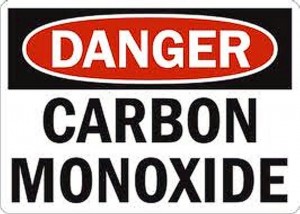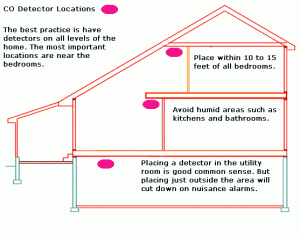 As you may or may not be aware, Pennsylvania passed a new carbon monoxide law (Act 121) as of December 18, 2013 that has a direct effect on how rental properties are operated. Although the verbiage in these laws can be confusing, we are going to break it down a bit to make it digestible.
As you may or may not be aware, Pennsylvania passed a new carbon monoxide law (Act 121) as of December 18, 2013 that has a direct effect on how rental properties are operated. Although the verbiage in these laws can be confusing, we are going to break it down a bit to make it digestible.
Before we discuss the rules to this new law, let’s first be sure that we understand the definitions of the items it refers to.
“Apartment” A room or suite of two or more rooms, occupied or leased for occupation, or intended or designed to be occupied, as a home.
“Multifamily dwelling” Any house or building, or portion thereof that is intended or designed to be occupied or leased for occupation, or occupied as a home or residence for three or more households living in separate apartments, and doing their cooking on the premises.
“Residential building” Detached one-family and two-family dwellings and multiple single-family dwellings that are not more than three stories in height with a separate means of entrance and exit, which includes accessory structures.
“Fossil fuel” Coal, kerosene, oil, wood, fuel gases and other petroleum or hydrocarbon products which put off carbon monoxide as a by-product of burning.
Ok, here is the meat and potatoes of the law as it applies to rental housing.
 Multifamily dwellings.–Each apartment in a multifamily dwelling, which uses a fossil fuel-burning heater or appliance, fireplace, or an attached garage, must have an operational, centrally located and approved carbon monoxide alarm installed in the vicinity of the bedrooms and the fossil fuel-burning heater or fireplace within 18 months of the effective date of this act.
Multifamily dwellings.–Each apartment in a multifamily dwelling, which uses a fossil fuel-burning heater or appliance, fireplace, or an attached garage, must have an operational, centrally located and approved carbon monoxide alarm installed in the vicinity of the bedrooms and the fossil fuel-burning heater or fireplace within 18 months of the effective date of this act.
Put carbon monoxide detectors in the area of the home where the bedrooms are, in the kitchen, near the heater, fireplace, AND the garage if the home has one by June 18, 2015.
Section 5. Carbon monoxide alarm requirements in rental properties.
(a) Owner responsibilities.–The owner of a multifamily dwelling having a fossil fuel-burning heater or appliance, fireplace or an attached garage used for rental purposes and required to be equipped with one or more approved carbon monoxide alarms shall:
(1) Provide and install an operational, centrally located and approved carbon monoxide alarm in the vicinity of the bedrooms and the fossil fuel-burning heater or fireplace.
(2) Replace, in accordance with this act, any approved carbon monoxide alarm that has been stolen, removed, found missing or rendered inoperable during a prior occupancy of the rental property and which has not been replaced by the prior occupant before the commencement of a new occupancy of the rental property.
(3) Ensure that the batteries in each approved carbon monoxide alarm are in operating condition at the time the new occupant takes residence in the rental property.
The owner of the rental property must provide carbon monoxide alarms in the bedroom area, the kitchen if it has gas appliances, near the fireplace and heater and near the garage. The owner must be sure to provide and install working carbon monoxide alarms before renting the unit to a new tenant if the prior tenant has not replaced or maintained the previously installed alarm during their lease. If all of the alarms are still in place, the owner must make sure that all the batteries in the alarms are working before putting new tenants in the unit.
(b) Maintenance, repair or replacement.–Except as provided in subsection (a), the owner of a multifamily dwelling used for rental purposes is not responsible for the maintenance, repair or replacement of an approved carbon monoxide alarm or the care and replacement of batteries while the building is occupied. Responsibility for maintenance and repair of carbon monoxide alarms shall revert to the owner of the building upon vacancy of the rental property.
(c) Occupant responsibilities.–The occupant of each multifamily dwelling used for rental purposes in which an operational and approved carbon monoxide alarm has been provided must:
(1) Keep and maintain the device in good repair.
(2) Test the device.
(3) Replace batteries as needed.
(4) Replace any device that is stolen, removed, missing or rendered inoperable during the occupancy of the building.
(5) Notify the owner or the authorized agent of the owner in writing of any deficiencies pertaining to the approved carbon monoxide alarm.
Once the tenant has signed the lease and is in possession of the rental unit, the tenant is then responsible for the carbon monoxide alarms. These responsibilities include the maintenance of the alarm, regularly testing and replacing the batteries as needed, replacing any missing or broken alarms and keeping the owner informed of any broken alarms during their lease.
If you would like to read the entire law you can read it here. Do keep in mind that you have 18 months to get these carbon monoxide alarms in place, but you don’t want to wait until the last minute to get them installed. Consider sending your maintenance technician with the alarms if they are going to do service at your units and just add it onto the service call. You could also add these alarms onto the list of things that need to be completed when the units are being turned over. Just create a tracking sheet of your properties and mark off the units as you go with the date that the installation was completed and have whoever completed the installation initial off on it.